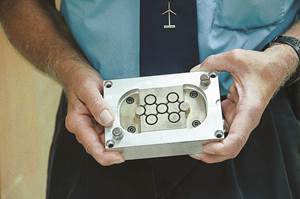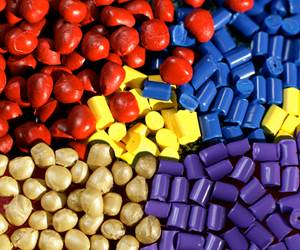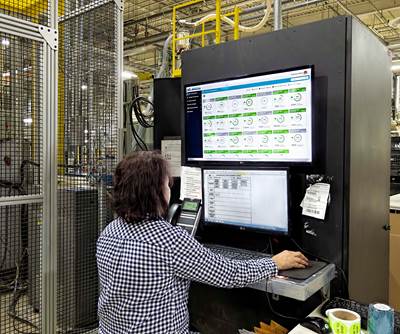Choosing the Right Gearbox and Motor for Your Single-Screw Extruder
Extruder OEMs are typically very good at sizing motors and gear boxes for extrusion applications. But you have the final decision on the acceptance of the design. Here’s what you should consider.
Gearbox and motor selection are important keys to the successful and economically optimized single-screw extrusion process. That is, the motor and gearbox should be selected such that the extruder operates at near 70% motor current load and about 70% of the maximum normal screw speed. This will allow a rate increase in the future and the extrusion of resins that are more viscous while minimizing the capital costs for the motor and gearbox.
If the gearbox and motor are not selected properly for the application, then the rate of the line can be limited by the extruder by either operating at maximum screw speed or maximum motor current. For most applications, either the most expensive segment of the line or the cooling process should be the rate limiting section of the line, and not the extruder.
This article focuses on setting the maximum screw speed for the extruder based on the maximum motor speed, gearbox reduction and belt sheaves, if used. Motor size depends on the application.
Original equipment manufacturers (OEMs) are typically very good at sizing motors and gearboxes for extrusion applications. But the purchaser has the final decision on the acceptance of the design. I have seen a very large number of extrusion applications that were set up optimally. That is, the motor and gearbox provided the proper speed and torque range for the screw at the target rate, discharge pressure and discharge temperature. An optimal design should also include a future rate increase of up to 20%.
In the last 35 years, however, I have optimized nearly 30 extruders that were configured with less than ideal motors and gearboxes. Most of these cases were because the extruders were purchased for a particular application and then repurposed for a new application that required a different torque and speed for the screw. But there were the occasional specifications of a poor motor and gearbox on new equipment.
I have optimized nearly 30 extruders that were configured with less than ideal motors and gearboxes.
Extrusion applications operate with different discharge temperatures. For polyethylenes (PEs), typical discharge temperatures and screw speeds for some of the most common applications are provided in the accompanying table. The discharge temperatures are controlled in general by the metering channel depth, screw speed and resin viscosity. For example, a cast film process requires that the discharge temperature be near 250oC. The temperature is typically obtained by using a screw with a metering channel depth that is about 6 mm for a 100-mm diameter extruder and a screw speed of about 100 rpm.

Typical discharge temperatures, screw speeds and metering channel depths for 100-mm diameter extruders running PE applications.
For this application, the motor and gearbox (and belt sheave if used) would provide a maximum screw speed of about 120 rpm. For extrusion coating applications, the discharge temperature is typically 300oC and the screw speed during extrusion would be near 220 rpm, and the screw would have a metering channel depth of about 3 mm. The motor and gearbox combination for cast film would not be suitable for extrusion coating because the extruder could only run at the maximum screw speed of 120 rpm, providing about half the required rate. Moreover, the slower screw speed would likely not obtain a discharge temperature of 300oC, even for a screw with a 3-mm deep metering channel.
Recall from high school physics that power for a rotating shaft or screw is equal to the torque multiplied by the rotation speed of the screw. The motor current is directly proportional to the motor torque. A convenient method to estimate the power inputted via the screw is by using this equation:

where P is the power that is required by the screw in hp, Pmax is the name-plate power (hp) for the motor, A is the motor current (amperage) observed during the extrusion, Amax is the name-plate motor current at full load, RPM is the screw speed during extrusion, and the RPMmax is the maximum screw speed that the extruder is capable of running (base speed).
It is easy to see that if the maximum screw speed is 200 rpm and the screw speed used for the extrusion is 100 rpm, the highest power that can be inputted to the screw is half the power from the motor. The maximum screw speed is simply the maximum motor speed divided by the gearbox reduction and belt sheave ratio. The maximum torque at the screw depends on the motor size and the speed reduction by the gearbox and belt sheave.
A gearbox built for extrusion coating was used as a replacement box on a cast film line. The gearbox and motor combination set the maximum screw speed to 200 rpm. The cast film process, however, operated at about 95 rpm, limiting the torque available to the screw. That is, the motor current was running at 98% of the maximum current during operation. The redesign of the screw was complicated because of the lack of torque. The design provided an acceptable rate, but the extrudate temperature was too high.
Typically, a screw designer will increase the metering channel depth to decrease the extrudate temperature to an optimal level. When the metering channel depth is increased, the specific rate increases and the motor current needed for the process will increase. For this line, decreasing the discharge temperature via screw design was not possible because the motor was already running at the maximum motor current.
Purchasing and upgrading extrusion systems should always design flexibility into the line that enables rate increases, alternative resins and process optimizations.
Recently, I examined several cast film extruders that were repurposed on extrusion coating lines. As previously discussed, the processes operate at different temperatures with PE cast film at about 250oC and extrusion coating at 300oC. The extruder had a maximum screw speed of 70 rpm. The motor was operating with 45% of maximum motor current. A new design can provide the proper extrudate temperature at low rate or a higher rate with an extrudate temperature that is too low. The compromise was to design at a low rate that met the high extrudate temperature requirement.
Gearboxes and motors on cooling extruders used in tandem foam sheet lines must be selected carefully. A schematic of a tandem foam sheet line is shown in the accompanying figure. The first extruder melts the resin and mixes in a physical blowing agent such as supercritical carbon dioxide. The discharge is typically about 235oC for polystyrene (PS). The resin, however, is too hot to foam. The cooling extruder decreases the PS mixture to about 140oC. The cooling extruder is larger in diameter than the first extruder, and the screw rotates very slowly and has channels that are very deep.

A new tandem foam sheet line was designed and installed with a conventional slotted screw in the cooling extruder. This screw runs at a relatively high specific rate and a screw speed of about 18.2 rpm. The motor and gearbox combination provided a maximum screw speed of 20 rpm from a 150 hp motor. This screw, however, could not decrease the material temperature consistently, resulting in a low quality and unusable foam.
A high-performance screw was designed and built that would increase the foam quality and the rate. The high-performance screw operated at a much higher specific rate, causing the screw speed to operate at 11.5 rpm for the same rate. At 11.5 rpm, only about 58% of the motor power could be delivered to the screw. The motor and gearbox were not capable of supplying enough power to the high-performance screw.
There are often belt drives between a gearbox and a motor that can be used to either increase the torque to the screw or increase the maximum speed to the screw. The belt drive sheaves were changed on the cooling extruder such that the new maximum speed was 15 rpm, enabling the input of 77% of the motor power to the screw. Changing the belt sheaves to a maximum screw speed of 15 rpm will decrease the service life of the gearbox because the maximum torque was increased on both the input and output shafts. The OEM should be contacted when a belt drive is changed to make sure that the service life and safety of the gearbox are not compromised.
Purchasing and upgrading extrusion systems should always design flexibility into the line that enables rate increases, alternative resins and process optimizations. Many of these upgrades will require additional screw speed and/or torque. A properly specified gearbox and motor speed will enable additional torque and screw speed to satisfy these optimizations.
About the Author: Mark A. Spalding is a fellow in Packaging & Specialty Plastics and Hydrocarbons R&D at Dow Inc. in Midland, Michigan. During his 37 years at Dow, he has focused on development, design and troubleshooting of polymer processes, especially in single-screw extrusion. He co-authored Analyzing and Troubleshooting Single-Screw Extruders with Gregory Campbell. Contact: 989-636-9849; maspalding@dow.com; dow.com.
Related Content
How to Select the Right Tool Steel for Mold Cavities
With cavity steel or alloy selection there are many variables that can dictate the best option.
Read MoreThe Importance of Melt & Mold Temperature
Molders should realize how significantly process conditions can influence the final properties of the part.
Read MoreFundamentals of Polyethylene – Part 6: PE Performance
Don’t assume you know everything there is to know about PE because it’s been around so long. Here is yet another example of how the performance of PE is influenced by molecular weight and density.
Read MoreInjection Molding: Focus on these Seven Areas to Set a Preventive Maintenance Schedule
Performing fundamental maintenance inspections frequently assures press longevity and process stability. Here’s a checklist to help you stay on top of seven key systems.
Read MoreRead Next
People 4.0 – How to Get Buy-In from Your Staff for Industry 4.0 Systems
Implementing a production monitoring system as the foundation of a ‘smart factory’ is about integrating people with new technology as much as it is about integrating machines and computers. Here are tips from a company that has gone through the process.
Read MoreBeyond Prototypes: 8 Ways the Plastics Industry Is Using 3D Printing
Plastics processors are finding applications for 3D printing around the plant and across the supply chain. Here are 8 examples to look for at NPE2024.
Read More



















